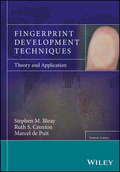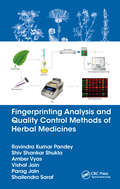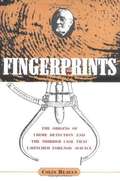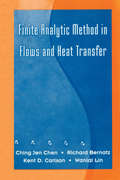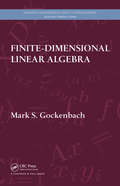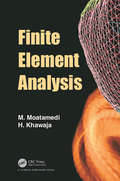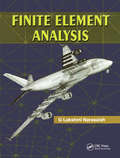- Table View
- List View
Finger Prints: The Classic 1892 Treatise
by Francis GaltonLandmark discusses the evidence validating fingerprints as a means of personal identification, permanence of the fingerprint characteristics, uniqueness of an assemblage of ridge details, and the variability and classifiable nature of finger patterns -- along with such fundamental investigations as biological and racial variations and the inheritance of fingerprint traits. 34 tables. 15 plates.
Fingerprint Analysis Laboratory Workbook, Second Edition
by Hillary Moses DaluzFingerprint collection and analysis may be performed as part of many jobs, including crime scene technician, latent print examiner, criminalist, and lab supervisor. Regardless of one’s specific background or role in the process, a knowledge of scientific practices is critical in handling and analyzing fingerprint evidence. The best way to understand the principles and concepts of any science learned in a classroom is to perform experiments. The exercises in Fingerprint Analysis Laboratory Workbook, Second Edition address all aspects of fingerprint theory, investigation, processing, comparisons, and research. Designed specifically to parallel the Fundamentals of Fingerprint Analysis, Second Edition textbook, the laboratory exercises correspond with the textbook chapters, with exercise in the lab chapter putting into practice the concepts covered in the text chapter. Each lab follows the same format, beginning with the objectives of the experiment and providing the background information necessary to perform the experiment. This is followed by a list of required materials, the lab exercises, and post-lab questions for students to test what they’ve learned. Many of the laboratory exercises may be completed either at home or in a laboratory setting. Exercises and photographs enhance the text, making it an ideal hands-on learning tool. New techniques and current practices added to the primary textbook have been included in this companion laboratory workbook to cover the latest in real-world application of fingerprint analysis science to practice.
Fingerprint Development Techniques: Theory and Application (Developments in Forensic Science)
by Stephen M. Bleay Ruth S. Croxton Marcel De PuitA comprehensive review of the latest fingerprint development and imaging techniques With contributions from leading experts in the field, Fingerprint Development Techniques offers a comprehensive review of the key techniques used in the development and imaging of fingerprints. It includes a review of the properties of fingerprints, the surfaces that fingerprints are deposited on, and the interactions that can occur between fingerprints, surfaces and environments. Comprehensive in scope, the text explores the history of each process, the theory behind the way fingerprints are either developed or imaged, and information about the role of each of the chemical constituents in recommended formulations. The authors explain the methodology employed for carrying out comparisons of effectiveness of various development techniques that clearly demonstrate how to select the most effective approaches. The text also explores how techniques can be used in sequence and with techniques for recovering other forms of forensic evidence. In addition, the book offers a guide for the selection of fingerprint development techniques and includes information on the influence of surface contamination and exposure conditions. This important resource: Provides clear methodologies for conducting comparisons of fingerprint development technique effectiveness Contains in-depth assessment of fingerprint constituents and how they are utilized by development and imaging processes Includes background information on fingerprint chemistry Offers a comprehensive history, the theory, and the applications for a broader range of processes, including the roles of each constituent in reagent formulations Fingerprint Development Techniques offers a comprehensive guide to fingerprint development and imaging, building on much of the previously unpublished research of the Home Office Centre for Applied Science and Technology.
Fingerprinting (Merit Badge Series)
by Boy Scouts of America StaffOutlines requirements for pursuing a merit badge in fingerprinting.
Fingerprinting Analysis and Quality Control Methods of Herbal Medicines
by Ravindra Kumar Pandey Shiv Shankar Shukla Amber Vyas Vishal Jain Parag Jain Shailendra SarafDue to the increase in the consumption of herbal medicine, there is a need to know which scientifically based methods are appropriate for assessing the quality of herbal medicines. Fingerprinting has emerged as a suitable technique for quality estimation. Chemical markers are used for evaluation of herbal medicines. Identification and quantification of these chemical markers are crucial for quality control of herbal medicines. This book provides updated knowledge on methodology, quality assessment, toxicity analysis and medicinal values of natural compounds.
Fingerprinting Techniques in Food Authentication and Traceability (Food Analysis & Properties)
by K. S. Siddiqi Leo M.L. NolletThere is an increasing interest by consumers for high-quality food products with a clear geographical origin. With these products in demand, suitable analytical techniques are needed for the quality control. Current analytical approaches are mass spectrometry techniques, spectroscopic techniques, separation techniques, and others. Fingerprinting Techniques in Food Authentication and Traceability discusses the principles of the techniques together with their advantages and drawbacks, and reported applications concerning geographical authenticity. A combination of methods analyzing different types of food compounds seems to be the most promising approach to establish the geographical origin. The abundant acquired data are analyzed by chemometrics. Producing safe and high-quality food is a prerequisite to ensure consumer health and successful domestic and international trade, and is critical to the sustainable development of national agricultural resources. Systems to trace food or feed products through specified stages of production, processing, and distribution play a key role in assuring food safety. Analytical techniques that enable the provenance of food to be determined provide an independent means of verifying traceability systems and also help to prove product authenticity, to combat fraudulent practices and to control adulteration, which are important issues for economic, religious, or cultural reasons. Proof of provenance has become an important topic in the context of food safety, food quality, and consumer protection in accordance with national legislation and international standards and guidelines.
Fingerprints: The Origins of Crime Detection and the Murder Case that Launched Forensic Science
by Colin BeavanHistory of how fingerprints came to be studied and used in forensics.
Fingerprints and Other Ridge Skin Impressions (International Forensic Science and Investigation)
by Christophe Champod Chris J. Lennard Pierre Margot Milutin StoilovicSince its publication, the first edition of Fingerprints and Other Ridge Skin Impressions has become a classic in the field. This second edition is completely updated, focusing on the latest technology and techniques—including current detection procedures, applicable processing and analysis methods—all while incorporating the expansive growth of literature on the topic since the publication of the original edition. Forensic science has been challenged in recent years as a result of errors, courts and other scientists contesting verdicts, and changes of a fundamental nature related to previous claims of infallibility and absolute individualization. As such, these factors represent a fundamental change in the way training, identifying, and reporting should be conducted. This book addresses these questions with a clear viewpoint as to where the profession—and ridge skin identification in particular—must go and what efforts and research will help develop the field over the next several years. The second edition introduces several new topics, including Discussion of ACE-V and research results from ACE-V studies Computerized marking systems to help examiners produce reports New probabilistic models and decision theories about ridge skin evidence interpretation, introducing Bayesnet tools Fundamental understanding of ridge mark detection techniques, with the introduction of new aspects such as nanotechnology, immunology and hyperspectral imaging Overview of reagent preparation and application Chapters cover all aspects of the subject, including the formation of friction ridges on the skin, the deposition of latent marks, ridge skin mark identification, the detection and enhancement of such marks, as well the recording of fingerprint evidence. The book serves as an essential reference for practitioners working in the field of fingermark detection and identification, as well as legal and police professionals and anyone studying forensic science with a view to understanding current thoughts and challenges in dactyloscopy.
Fingerprints of God: What Science Is Learning About the Brain and Spiritual Experience
by Barbara Bradley HagertyFrom the award-winning NPR religion correspondent and author of Life Reimagined: The Science, Art, and Opportunity of Midlife comes a fascinating investigation of how science is seeking to answer the question that has puzzled humanity for generations: Can science explain God? Is spiritual experience real or a delusion? Are there realities that we can experience but not easily measure? Does your consciousness depend entirely on your brain, or does it extend beyond? In Fingerprints of God, award-winning journalist Barbara Bradley Hagerty delves into the discoveries science is making about how faith and spirituality affect us physically and emotionally as it attempts to understand whether the ineffable place beyond this world can be rationally -even scientifically-explained. Hagerty interviews some of the world's top scientists to describe what their groundbreaking research reveals about our human spiritual experience. From analyses of the brain functions of Buddhist monks and Carmelite nuns, to the possibilities of healing the sick through directed prayer, to what near-death experiences illuminate about the afterlife, Hagerty reaches beyond what we think we know to understand what happens to us when we believe in a higher power. Paralleling the discoveries of science is Hagerty's own account of her spiritual evolution. Raised a Christian Scientist, she was a scrupulous adherent until a small moment as an adult triggered a revaluation of her beliefs, which in turn led her to a new way of thinking about God and faith. An insightful examination of what science is learning about how and why we believe, Fingerprints of God is also a moving story of one person's search for a communion with a higher power and what she discovered on that journey.From the Hardcover edition.
Fingerprints of God
by Hagerty Barbara BradleyFrom the award-winning NPR religion correspondent comes a fascinating investigation of how science is seeking to answer the question that has puzzled humanity for generations: Can science explain God? Is spiritual experience real or a delusion? Are there realities that we can experience but not easily measure? Does your consciousness depend entirely on your brain, or does it extend beyond? In Fingerprints of God, award-winning journalist Barbara Bradley Hagerty delves into the discoveries science is making about how faith and spirituality affect us physically and emotionally as it attempts to understand whether the ineffable place beyond this world can be rationally -even scientifically-explained. Hagerty interviews some of the world's top scientists to describe what their groundbreaking research reveals about our human spiritual experience. From analyses of the brain functions of Buddhist monks and Carmelite nuns, to the possibilities of healing the sick through directed prayer, to what near-death experiences illuminate about the afterlife, Hagerty reaches beyond what we think we know to understand what happens to us when we believe in a higher power. Paralleling the discoveries of science is Hagerty's own account of her spiritual evolution. Raised a Christian Scientist, she was a scrupulous adherent until a small moment as an adult triggered a revaluation of her beliefs, which in turn led her to a new way of thinking about God and faith. An insightful examination of what science is learning about how and why we believe, Fingerprints of God is also a moving story of one person's search for a communion with a higher power and what she discovered on that journey. .
Fingerprints of the Gods: The Evidence of Earth's Lost Civilization
by Graham HancockThe bestselling author of The Sign and the Seal reveals the true origins of civilization. Connecting puzzling clues scattered throughout the world, Hancock discovers compelling evidence of a technologically and culturally advanced civilization that was destroyed and obliterated from human memory. Four 8-page photo inserts.
Fingers Came First
by Amy TaoOwen’s mom won’t let him eat with his fingers. Instead, he has to use a fork! He doesn’t understand why he can’t use his fingers like his baby sister. To understand why he has to use a fork, Owen and his family go to the library to find out about the history of utensils.
Fingers in the Sparkle Jar: A Memoir
by Chris PackhamVoted the UK’s Favourite Nature BookThe memoir that inspired Chris Packham's BBC documentary, Asperger’s and MeEvery minute was magical, every single thing it did was fascinating and everything it didn't do was equally wondrous, and to be sat there, with a Kestrel, a real live Kestrel, my own real live Kestrel on my wrist! I felt like I'd climbed through a hole in heaven's fence.An introverted, unusual young boy, isolated by his obsessions and a loner at school, Chris Packham only felt at ease in the fields and woods around his suburban home. But when he stole a young Kestrel from its nest, he was about to embark on a friendship that would teach him what it meant to love, and that would change him forever. In his rich, lyrical and emotionally exposing memoir, Chris brings to life his childhood in the 70s, from his bedroom bursting with fox skulls, birds' eggs and sweaty jam jars, to his feral adventures. But pervading his story is the search for freedom, meaning and acceptance in a world that didn’t understand him.Beautifully wrought, this coming-of-age memoir will be unlike any you've ever read.
Fingerübungen der Physik: Repetitorium und Übungsbuch mit Lösungen und MATLAB-Programmen
by Michael Kaschke Holger CartariusDieses Lehr- und Lernbuch erscheint in mehreren Bänden und ist gleichsam ein Repetitorium als auch Arbeitsbuch zu wenig behandelten Kapiteln des Physikstudiums. In diesem Band wird die Physik der Bewegung von Körpern und des Kontinuums behandelt. Zahlreiche spannende Probleme aus dem Alltag, der Physikgeschichte und der modernen Forschung werden sowohl anschaulich erklärt als auch mathematisch-physikalisch beschrieben. Die ausführlichen Lösungsvorschläge mit MATLAB-Programmen dienen dabei als „Fingerübungen“ für ein tieferes physikalisches Verständnis. Der Inhalt Physik der Bewegung – Physik des Kontinuums Die Zielgruppe Das Buch richtet sich an alle, die Freude an der Physik haben und diese für verschiedene Fragestellungen anwenden wollen. Besonderen Nutzen daraus werden Studierende und Promovierende der Physik, Mathematik und Ingenieurswissenschaften, ebenso wie des Lehramtes für naturwissenschaftliche Fächer gewinnen. Genauso ist das Buch für Dozentinnen und Dozenten der Physik an Hochschulen und Universitäten gedacht, aber auch für Lehrkräfte der Physik an Gymnasien, die aus dem Fundus der Übungen und Beispiele Anregungen für eigene Problemstellungen und Projekte gewinnen können. Vorkenntnisse Das Physikwissen des Bachelor-Studiums stellt in etwa die Grundlage dar, auf der das Buch aufbaut. Eine Reihe von Kapiteln lassen sich auch mit den Kenntnissen eines Leistungskurses Physik an den Gymnasien erschließen. Die Übungsaufgaben sind nach 3 Schwierigkeitsklassen gegliedert.
Fingerübungen der Physik: Repetitorium und Übungsbuch mit Lösungen und MATLAB-Programmen
by Michael Kaschke Holger CartariusDieses Lehr- und Lernbuch erscheint in mehreren Bänden und ist gleichsam ein Repetitorium als auch Arbeitsbuch zu wenig behandelten Kapiteln des Physikstudiums. In diesem Band wird die Physik der Bewegung von Körpern im Weltall behandelt. Zahlreiche spannende Probleme aus dem Alltag, der Physikgeschichte und der modernen Forschung werden sowohl anschaulich erklärt als auch mathematisch-physikalisch beschrieben. Die ausführlichen Lösungsvorschläge mit MATLAB-Programmen dienen dabei als „Fingerübungen“ für ein tieferes physikalisches Verständnis. Der Inhalt Himmelsmechanik – Astrodynamik Die Zielgruppe Das Buch richtet sich an alle, die Freude an der Physik haben und diese für verschiedene Fragestellungen anwenden wollen. Besonderen Nutzen daraus werden Studierende und Promovierende der Physik, Mathematik und Ingenieurswissenschaften, ebenso wie des Lehramtes für naturwissenschaftliche Fächer gewinnen. Genauso ist das Buch für Dozentinnen und Dozenten der Physik an Hochschulen und Universitäten gedacht, aber auch für Lehrkräfte der Physik an Gymnasien, die aus dem Fundus der Übungen und Beispiele Anregungen für eigene Problemstellungen und Projekte gewinnen können. Vorkenntnisse Das Physikwissen des Bachelor-Studiums stellt in etwa die Grundlage dar, auf der das Buch aufbaut. Eine Reihe von Kapiteln lassen sich auch mit den Kenntnissen eines Leistungskurses Physik an den Gymnasien erschließen. Die Übungsaufgaben sind nach 3 Schwierigkeitsklassen gegliedert.
Finite Analytic Method in Flows and Heat Transfer
by R. A. BernatzThis book contains the fundamental development of the finite analytic method and gives a systematic coverage of knowledge needed for numerical computation of fluid flows and heat transfer. It will be helpful to many including graduate students studying computational fluid dynamics and heat transfer.
Finite Approximations in Discrete-Time Stochastic Control: Quantized Models And Asymptotic Optimality (Systems And Control: Foundations And Applications Ser.)
by Serdar Yüksel Tamás Linder Naci SaldiIn a unified form, this monograph presents fundamental results on the approximation of centralized and decentralized stochastic control problems, with uncountable state, measurement, and action spaces. It demonstrates how quantization provides a system-independent and constructive method for the reduction of a system with Borel spaces to one with finite state, measurement, and action spaces. In addition to this constructive view, the book considers both the information transmission approach for discretization of actions, and the computational approach for discretization of states and actions. Part I of the text discusses Markov decision processes and their finite-state or finite-action approximations, while Part II builds from there to finite approximations in decentralized stochastic control problems. This volume is perfect for researchers and graduate students interested in stochastic controls. With the tools presented, readers will be able to establish the convergence of approximation models to original models and the methods are general enough that researchers can build corresponding approximation results, typically with no additional assumptions.
Finite Difference Methods in Heat Transfer (Heat Transfer)
by M. Necati Özişik Helcio R. Orlande Marcelo J. Colaço Renato M. CottaFinite Difference Methods in Heat Transfer, Second Edition focuses on finite difference methods and their application to the solution of heat transfer problems. Such methods are based on the discretization of governing equations, initial and boundary conditions, which then replace a continuous partial differential problem by a system of algebraic equations. Finite difference methods are a versatile tool for scientists and for engineers. This updated book serves university students taking graduate-level coursework in heat transfer, as well as being an important reference for researchers and engineering. Features Provides a self-contained approach in finite difference methods for students and professionals Covers the use of finite difference methods in convective, conductive, and radiative heat transfer Presents numerical solution techniques to elliptic, parabolic, and hyperbolic problems Includes hybrid analytical–numerical approaches
Finite-Dimensional Linear Algebra (Discrete Mathematics and Its Applications)
by Mark S. GockenbachThis text provides a solid foundation for the study of advanced mathematics and covers many interesting applications of linear algebra, which show how linear algebra is essential in such diverse areas as combinatorics, differential equations, optimization, and approximation. The book discusses important concepts and methods from numerical linear algebra and contains a range of exercises in each section, including some that can be solved using a computer package such as MATLAB. It also incorporates mini-projects that encourage students to develop topics not covered in the text. A forthcoming solutions manual is available for qualifying instructors.
Finite Element Analysis
by M Moatamedi Hassan A. KhawajaFinite element analysis has become the most popular technique for studying engineering structures in detail. It is particularly useful whenever the complexity of the geometry or of the loading is such that alternative methods are inappropriate. The finite element method is based on the premise that a complex structure can be broken down into finitely many smaller pieces (elements), the behaviour of each of which is known or can be postulated. These elements might then be assembled in some sense to model the behaviour of the structure. Intuitively this premise seems reasonable, but there are many important questions that need to be answered. In order to answer them it is necessary to apply a degree of mathematical rigour to the development of finite element techniques. The approach that will be taken in this book is to develop the fundamental ideas and methodologies based on an intuitive engineering approach, and then to support them with appropriate mathematical proofs where necessary. It will rapidly become clear that the finite element method is an extremely powerful tool for the analysis of structures (and for other field problems), but that the volume of calculations required to solve all but the most trivial of them is such that the assistance of a computer is necessary. As stated above, many questions arise concerning finite element analysis. Some of these questions are associated with the fundamental mathematical formulations, some with numerical solution techniques, and others with the practical application of the method. In order to answer these questions, the engineer/analyst needs to understand both the nature and limitations of the finite element approximation and the fundamental behaviour of the structure. Misapplication of finite element analysis programs is most likely to arise when the analyst is ignorant of engineering phenomena.
Finite Element Analysis
by Lakshmi NarasaihaThe finite element method has undergone a major paradigm shift from a detailed mathematical background for writing tailor-made computer programs to a user-based approach for applying available software to engineering analysis and design scenarios. This textbook begins with a concise overview of fluid mechanics, motivated by numerous engineering app
Finite Element Analysis: Thermomechanics of Solids, Second Edition
by David W. NicholsonExplore a Unified Treatment of the Finite Element MethodThe finite element method has matured to the point that it can accurately and reliably be used, by a careful analyst, for an amazingly wide range of applications. With expanded coverage and an increase in fully solved examples, the second edition of Finite Element Analysis: Thermomechan
Finite Element Analysis for Biomedical Engineering Applications
by Z. C. YangFinite element analysis has been widely applied to study biomedical problems. This book aims to simulate some common medical problems using finite element advanced technologies, which establish a base for medical researchers to conduct further investigations. This book consists of four main parts: (1) bone, (2) soft tissues, (3) joints, and (4) implants. Each part starts with the structure and function of the biology and then follows the corresponding finite element advanced features, such as anisotropic nonlinear material, multidimensional interpolation, XFEM, fiber enhancement, UserHyper, porous media, wear, and crack growth fatigue analysis. The final section presents some specific biomedical problems, such as abdominal aortic aneurysm, intervertebral disc, head impact, knee contact, and SMA cardiovascular stent. All modeling files are attached in the appendixes of the book. This book will be helpful to graduate students and researchers in the biomedical field who engage in simulations of biomedical problems. The book also provides all readers with a better understanding of current advanced finite element technologies. Details finite element modeling of bone, soft tissues, joints, and implants Presents advanced finite element technologies, such as fiber enhancement, porous media, wear, and crack growth fatigue analysis Discusses specific biomedical problems, such as abdominal aortic aneurysm, intervertebral disc, head impact, knee contact, and SMA cardiovascular stent Explains principles for modeling biology Provides various descriptive modeling files
Finite Element Analysis In Heat Transfer: Basic Formulation & Linear Problems (Computational and Physical Processes in Mechanics and Thermal Sciences)
by Gianni CominiThis introductory text presents the applications of the finite element method to the analysis of conduction and convection problems. The book is divided into seven chapters which include basic ideas, application of these ideas to relevant problems, and development of solutions. Important concepts are illustrated with examples. Computer problems are also included to facilitate the types of solutions discussed.
Finite Element Analysis of Composite Materials using Abaqus® (Composite Materials)
by Ever J. BarberoDeveloped from the author’s course on advanced mechanics of composite materials, Finite Element Analysis of Composite Materials with Abaqus® shows how powerful finite element tools tackle practical problems in the structural analysis of composites. This Second Edition includes two new chapters on "Fatigue" and "Abaqus Programmable Features" as well as a major update of chapter 10 "Delaminations" and significant updates throughout the remaining chapters. Furthermore, it updates all examples, sample code, and problems to Abaqus 2020. Unlike other texts, this one takes theory to a hands-on level by actually solving problems. It explains the concepts involved in the detailed analysis of composites, the mechanics needed to translate those concepts into a mathematical representation of the physical reality, and the solution of the resulting boundary value problems using Abaqus. The reader can follow a process to recreate every example using Abaqus graphical user interface (CAE) by following step-by-step directions in the form of pseudo-code or watching the solutions on YouTube. The first seven chapters provide material ideal for a one-semester course. Along with offering an introduction to finite element analysis for readers without prior knowledge of the finite element method, these chapters cover the elasticity and strength of laminates, buckling analysis, free edge stresses, computational micromechanics, and viscoelastic models for composites. Emphasizing hereditary phenomena, the book goes on to discuss continuum and discrete damage mechanics as well as delaminations and fatigue. The text also shows readers how to extend the capabilities of Abaqus via "user subroutines" and Python scripting. Aimed at advanced students and professional engineers, this textbook features 62 fully developed examples interspersed with the theory, 82 end-of-chapter exercises, and 50+ separate pieces of Abaqus pseudo-code that illustrate the solution of example problems. The author’s website offers the relevant Abaqus and MATLAB model files available for download, enabling readers to easily reproduce the examples and complete the exercises. Video recording of solutions to examples are available on YouTube with multilingual captions.


